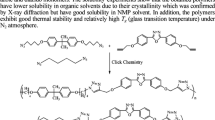Abstract
2(2,4-Dihydroxyphenyl)2H-benzotriazole has been prepared in about 50% yield by condensation ofo-nitrobenzenediazonium chloride with resorcinol followed by reductive cyclization of the initially obtained azo compound with zinc and sodium hydroxide. The condensation of the diazonium salt had to be carried out under carefully controlled conditions and in acidic medium, otherwise “bis”-condensation occurred which, after reductive cyclization, yielded 2(2,4-dihydroxyphenyl)1,3-2H-dibenzotriazole. 2(2,4-Dihydroxyphenyl)2H-benzotriazole was allowed to react with acryloyl or methacryloyl chloride. Monoacylation in the 4-position occurred by interfacial acylation technique and 2[2-hydroxy-4-acryloxy (or 4-methacryloxy)]2H-benzotriazole was obtained in over 60% yield. The two monomers were homopolymerized and copolymerized with styrene, methyl methacrylate, andn-butyl acrylate to polymers of high molecular weight. Incorporation of 2[2-hydroxy-4-acryloxy (or 4-methacryloxy)]2H-benzotriazole into the copolymer was from 1 to 10 mol% of the comonomer mixture. The ultraviolet spectra of monomers, homo- and copolymers were also determined.
Zusammenfassung
2(2,4-Dihydroxyphenyl)2H-benzotriazol wurde mit 50% Ausbeute über die Kondensation vono-Nitrobenzoldiazoniumchlorid mit Resorcin, gefolgt von reduktiver Cyclisierung der ursprünglich erhaltenen Azoverbindung mit Zn/NaOH, erhalten. Die Kondensation des Diazonium-Salzes hatte unter sorgfältig kontrollierten Bedingungen und im sauren Medium zu erfolgen, da ansonsten „Bis“-Kondensation auftrat, die nach der reduktiven Cyclisierung 2(2,4-Dihydroxyphenyl)1,3-2H-dibenzotriazol ergab. 2(2,4-Dihydroxyphenyl)2H-benzotriazol wurde mit Acryoyl- bzw. Methacryloylchlorid zur Reaktion gebracht, wobei die Monoacetylierungsprodukte in über 60% Ausbeute gewonnen wurden. Die beiden Monomeren wurden homopolymerisiert und mit Styrol, Methylmethacrylat undn-Butylacrylat zu Polymeren hohen Molekulargewichts copolymerisiert. Die Inkorporierung von 2[2-Hydroxy-4-acryloxy (bzw. 4-methacryloxy)]2H-benzotriazol in das Copolymer erfolgte zwischen 1 und 10 mol% der Comonomer-Mischung. Die UV-Spektren der Monomeren, Homo- und Copolymeren sind angegeben.
Similar content being viewed by others
References
Balaban L.,Borkovec, J.,Rysavy D., Czechoslovakian Pat. 108,792 (1963); C.A.61, 3267 h (1964).
Belusa J., Janousek Z., Knoflickova H., Chem. Zvesti28, 673 (1974).
Yoshida S., Vogl O., Polymer Preprints, ACS Division of Polymer Chemistry21, 203 (1980).
Vogl O., Yoshida S., Preprints, Plenary Lectures, Annual Meeting, Society of Polymer Science (Kyoto),29 (4), 648 (1980).
Vogl O., Yoshida S., Rev. Roum. de Chimie7, 1123 (1980).
Yoshida S., Vogl O., Makromol. Chem.183, 259 (1982).
Yoshida S., Lillya C. P., Vogl O., J. Polym. Sci., Polym. Chem. Ed.20, 2215 (1982).
Nir Z., Gupta A., Vogl O., J. Polym. Sci., Polym. Chem. Ed.20, 2735 (1982).
Karvas M., Holcik J., Chem. Prum.17, 543 (1967).
Heller H.,Rody J.,Keller E., Swiss Pat. 410,851; C.A.66, 86576 (1966).
Brit. Pat. 974,713; C.A.62, 16259 (1965).
Elbs K., Keiper W., J. Prakt. Chem. [2]67, 580 (1905).
Elbs K., J. Prakt. Chem.108, 209 (1924).
Li S. J., Gupta A., Vogl O., Monatsh. Chem.114, 937 (1983).
Mannens M. G.,Hove J. J.,Aarschot W. J.,Priem J. J., U.S.-Pat. 3,813,255 (1974).
Raich W. J., U.S.-Pat. 2,938,883 (1960); C.A.54, 20331 a (1960).
Osawa Z., Matsui K., Ogiwara Y., J. Macromol. Sci. Chem.A 1 (4), 581 (1967).
Tocker S., U.S.-Pat. 3,107,199 (1963); C.A.57, 10861 (1962).
Tocker S., Brit. Pat. 985,355 (1963); C.A.61, 8484 (1964).
Brit. Pat. 979,868 (1963); C.A.60, 13453 (1964).
Fertig J., Goldberg A. I., Skoultchi M., J. Appl. Poly. Sci.9, 903 (1965).
Osawa Z., Suzuki M., Ogiwara Y., Sugaya I., Hirama K., Kasuga T., J. Macromol. Sci. Chem.5 (2), 275 (1971).
Author information
Authors and Affiliations
Additional information
This paper is dedicated to Professor Dr.Karl Schlögl on the occasion of his 60th birthday with our warmest wishes.
Part XXVI:W. Dickstein andO. Vogl, J. Macromol. Sci., Chem., in press.
Rights and permissions
About this article
Cite this article
Li, S., Albertsson, AC., Gupta, A. et al. Functional polymers. XXVII: 2[2-hydroxy-4-acryloxy(methacryloxy)phenyl]2H-benzotriazole: Monomers, polymers, and copolymers. Monatsh Chem 115, 853–868 (1984). https://doi.org/10.1007/BF01120980
Received:
Accepted:
Published:
Issue Date:
DOI: https://doi.org/10.1007/BF01120980




